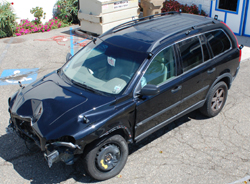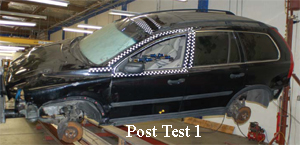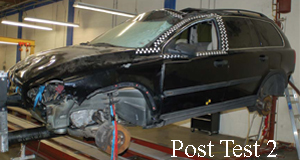 |
Jordan Rollover System Dynamic Rollover Testing (JRS)
Test results: The results of the first Dynamic Rollover Test that was performed on the test vehicle are presented in this section. In the test, the vehicle dropped as planned and contacted the front near and far sides of the roof structure. Test 1 – 7/24/2006 Summary of Test Results
The vertical load cells mounted on the roadway platform show the near and far side impacts. The vehicle struck the roadway on the near side at approximately 1.80 seconds. The entire roll sequence was completed by approximately 2.12 seconds. The string potentiometers located on the fixture support towers show the vertical vehicle motion throughout the test. The front of the vehicle dropped approximately 4.5 inches before contacting the roadway. The rear of the vehicle dropped approximately 3.7 inches before contacting the roadway. The vehicle was pitched at 5.2 degrees at contact. The roll encoder located on the cable pulley shows the roadway velocity throughout the test. The roadway was traveling at 14.4 mph at contact. The roll encoder placed on the vehicle rotation shaft yields the vehicle roll angle during the test. The roll angle of the vehicle was 140 degrees at the roadway impact. The vehicle roll rate was obtained from the roll angle roll encoder. At initial contact, the vehicle roll rate was 194 degrees per second. Test results, Data Tables and selected comparison photographs for Test 2. The results of the second Dynamic Rollover Test that was performed on the test vehicle are presented in this section. In the test, the vehicle dropped as planned and contacted the front near and far sides of the roof structure. Test 2 – 7/24/2006 Summary of Test Results
The vertical load cells mounted on the roadway platform show the near and far side impacts. The vehicle struck the roadway on the near side at approximately 1.75 seconds. The entire roll sequence was completed by approximately 2.04 seconds. The string potentiometers located on the fixture support towers show the vertical vehicle motion throughout the test. The front of the vehicle dropped approximately 4.8 inches before contacting the roadway. The rear of the vehicle dropped approximately 3.9 inches before contacting the roadway. The vehicle was pitched at 5.3 degrees at contact. The roll encoder located on the cable pulley shows the roadway velocity throughout the test. The roadway was traveling at 14.6 mph at contact. The roll encoder placed on the vehicle rotation shaft yields the vehicle roll angle during the test. The roll angle of the vehicle was 150 degrees at the roadway impact. The vehicle roll rate was obtained from the roll angle roll encoder. At initial contact, the vehicle roll rate was 199 degrees per second. |
||||||||||||||||||||||||||||||||||||||||||||||||||||||||||||||||||||||||||||||||||||||||||||||


